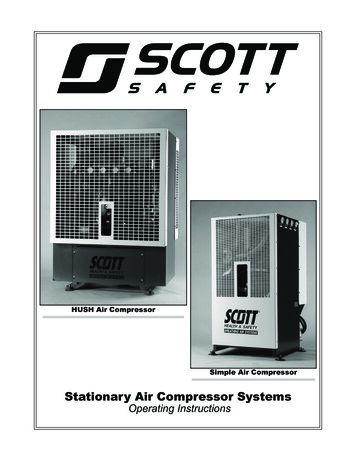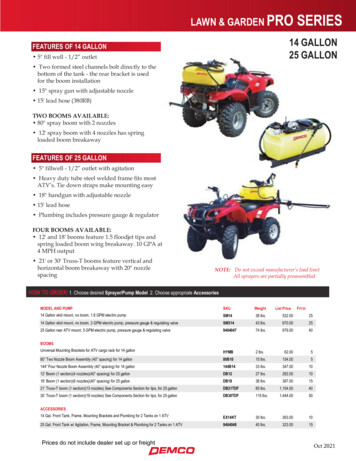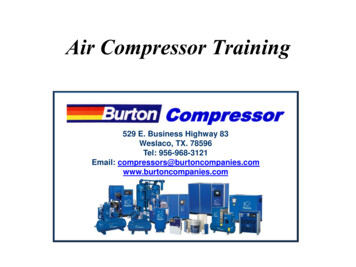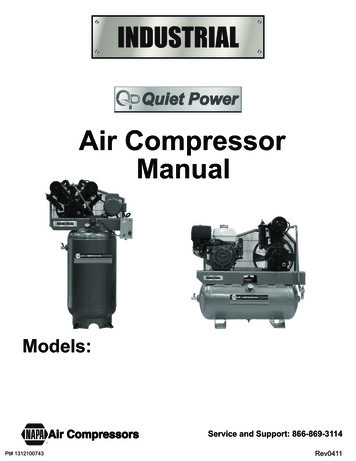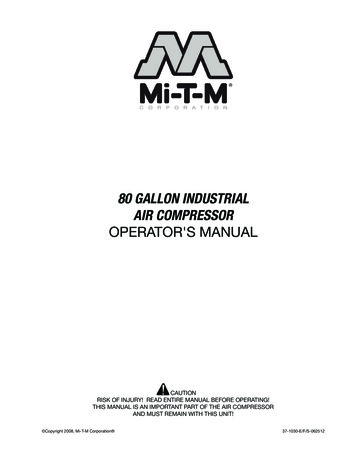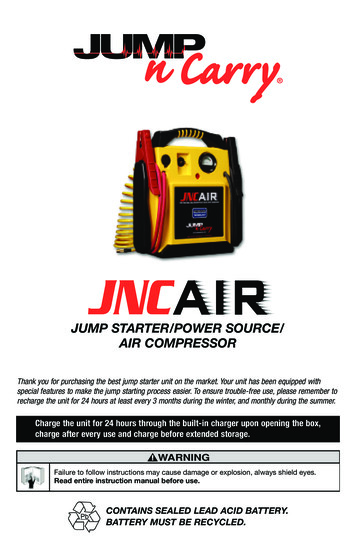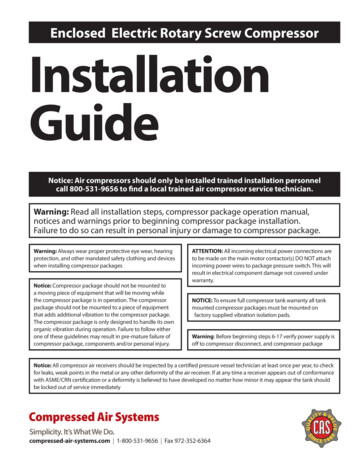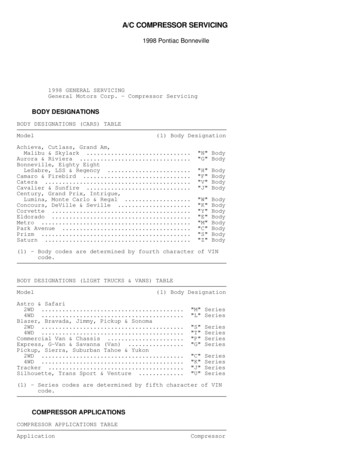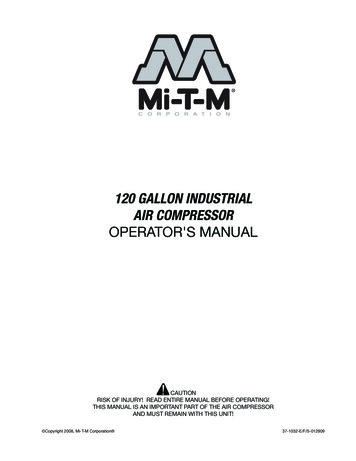
Transcription
120 GALLON INDUSTRIALAIR COMPRESSOROPERATOR'S MANUALCAUTIONRISK OF INJURY! READ ENTIRE MANUAL BEFORE OPERATING!THIS MANUAL IS AN IMPORTANT PART OF THE AIR COMPRESSORAND MUST REMAIN WITH THIS UNIT! Copyright2008, Mi-T-MCorporation Stationary ElectricAir CompressorManual37-1032-E/F/S-012809
Table of tant safety instructions. .4-7Risk of electric shock or electrocution.4Risk of explosion or fire.5Risk of bursting.5Risk to breathing.6Risk of burns.6Risk of flying objects.6Risk from moving parts.7Risk from negligence.7Risk of air compressor damage.7Air compressor specifications.8Feature drawings & review. 8-11Notes.12Preparation instructions. 14-15Initial set-up.14Location.14Electrical.15Pre-start checklist.15Operating instructions.16Start-up.16Shutdown.16Maintenance instructions.16Troubleshooting. 17-19Warranty.20Notes.21 Stationary Electric Air Compressor Manual
INTRODUCTIONCongratulations on the purchase of your new Mi-T-M Air Compressor! You can be assured your Mi-T-M Air Compressor was constructed with the highest level of precision and accuracy. Each component hasbeen rigorously tested by technicians to ensure the quality, endurance and performance of this air compressor.This operator's manual was compiled for your benefit. By reading and following the simple safety, installation and operation, maintenance and troubleshooting steps described in this manual, you will receive yearsof troublefree operation from your new Air Compressor. The contents of this manual are based on the latestproduct information available at the time of publication. The Manufacturer reserves the right to make changes in price, color, materials equipment, specifications or models at any time without notice.important!A "DANGER, WARNING or CAUTION" safety warning will be surrounded by a "SAFETY ALERT BOX". Thisbox is used to designate and emphasize Safety Warnings that must be followed when operating this aircompressor. Accompanying the safety warnings are "Signal Words" which designate the degree or level ofhazard seriousness. The "Signal Words" used in this manual are as follows:DANGER: Indicates an imminently hazardous situation which, if not avoided, WILLresult in death or serious injury.WARNING: Indicates a potentially hazardous situation which, if not avoided,COULD result in death or serious injury.CAUTION: Indicates a potentially hazardous situation which, if not avoided MAYresult in minor or moderate injury or damage to the air compressor.The symbols set below are "Safety Alert Symbols". These symbols are used to call attention to items orprocedures that could be dangerous to you or other persons using this equipment.ALWAYS PROVIDE A COPY OF THIS MANUAL TO ANYONE USING THIS EQUIPMENT. READ ALLINSTRUCTIONS IN THIS MANUAL AND ANY INSTRUCTIONS SUPPLIED BY MANUFACTURERSOF SUPPORTING EQUIPMENT BEFORE OPERATING THIS AIR COMPRESSOR AND ESPECIALLYPOINT OUT THE "SAFETY WARNINGS" TO PREVENT THE POSSIBILITY OF PERSONAL INJURYTO THE OPERATOR.Once the unit has been uncrated, immediately write in the serial number of your unit in the space providedbelow.SERIAL NUMBERInspect for signs of obvious or concealed freight damage. If damage does exist, file a claim with the transportation company immediately. Be sure that all damaged parts are replaced an that the mechanical andelectrical problems are corrected prior to operation of the unit. If you require service, contact Mi-T-M Customer Service.Mi-T-M Corporation, 8650 Enterprise Drive, Peosta, IA 52068563-556-7484 / 800-553-9053 / Fax 563-556-1235Monday - Friday 8:00 a.m. - 5:00 p.m. CSTPlease have the following information available for all service calls:1. Model Number2. Serial Number3. Date and Place of PurchaseStationary Electric Air Compressor Manual
IMPORTANT SAFETY INSTRUCTIONSREAD ALL SAFETY WARNINGS BEFORE USING AIR COMPRESSORHazardRISK OF ELECTRICSHOCK ORELECTROCUTIONPotential ConsequenceSerious injury or death couldoccur if the air compressor isnot properly grounded. Yourair compressor is powered byelectricity and may cause electric shock or electrocution if notused properly.PreventionInstallation of this unit, includingall electrical connections, mustcomply with all local, state andnational codes.This product must be grounded.Connect to a GFCI circuit breakerwhen available. If the unit shouldmalfunction or breakdown,grounding provides a path of leastresistance for electric current to reduce the risk of electric shock. Donot ground to a gas supply line.Improper connection of theequipment-grounding conductorcan result in a risk of electrocution. Check with a qualified electrician or service personnel if youare in doubt as to whether thesystem is properly grounded.Always be certain the unit is receiving proper voltage ( /- 5% ofthe voltage listed on the nameplate). Before installing electricalconnections, be certain the powerswitches are in the "OFF" position.Keep all connections dry and offthe ground.Electrical shock may occur if theair compressor is not operatedproperly.Never operate air compressor inwet conditions.Serious injury or death mayoccur if electrical repairs are attempted by unqualified persons.Any electrical wiring or repairsperformed on this air compressor should be done by AuthorizedService Personnel in accordancewith National and Local electricalcodes.Never operate air compressorwith safety guards/covers removed or damaged.Before opening any electricalenclosure, always shut off theair compressor, relieve pressureand unplug the air compressorfrom the power source. Allow aircompressor to cool down. Neverassume the air compressor issafe to work on just because it isnot operating. It could restart atany time! Service in a clean, dry,flat area. Stationary Electric Air Compressor Manual
IMPORTANT SAFETY INSTRUCTIONSHazardRISK OF EXPLOSION ORFIREPotential ConsequenceSerious injury or death mayoccur from normal electricalsparks in motor and pressureswitchPreventionAlways operate air compressorin a well ventilated area free offlammable vapors, combustibledust, gases or other combustiblematerials.DO NOT SMOKE if sprayingflammable material. Locate theair compressor at least 20 feetaway from the spray area. (Anadditional hose may be required.)RISK OF BURSTINGSerious injury may occur if anyair compressor ventilation openings are restricted, causing theair compressor to overheat andstart a fire.Never place objects against oron top of air compressor. Operate air compressor at least 12inches away from any wall orobstruction that would restrictproper ventilation.Serious injury or death mayoccur from an air tank explosion if air tanks are not properlymaintained.Drain air tank daily or after eachuse to prevent moisture buildupin the air tank.Serious injury may occur froman air compressor malfunction or exploding accessories ifincorrect system components,attachments or accessories areused.Never make adjustments to thefactory set pressures.If air tank develops a leak,replace the air tank immediately. Never repair, weld or makemodifications to the air tank or itsattachments. Use only genuinemanufacturer repair parts foryour air compressor.Never exceed manufacturersmaximum allowable pressure rating of attachments.Because of extreme heat, do notuse plastic pipe or lead tin soldered joints for a discharge line.Never use air compressor to inflate small, low pressure objectssuch as toys.Stationary Electric Air Compressor Manual
IMPORTANT SAFETY INSTRUCTIONSHazardRISK TO BREATHINGPotential ConsequencePreventionSerious injury or death couldoccur from inhaling compressedair. The air stream may containcarbon monoxide, toxic vaporsor solid particles.Never inhale air from the air compressor either directly or from abreathing device connected tothe air compressor.Sprayed materials such aspaint, paint solvents, paint remover, insecticides, weed killers, etc. contain harmful vaporsand poisons.Operate air compressor only ina well ventilated area. Follow allsafety instructions provided withthe materials you are spraying.Use of a respirator may be required when working with somematerials.RISK OF BURNSSerious injury could occur fromtouching exposed metal parts.These areas can remain hot forsome time after the air compressor is shutdown.Never allow any part of yourbody or other materials to makecontact with any exposed metalparts on the air compressor.RISK FROMFLYING OBJECTSSerious injury can occur fromloose debris being propelled ata high speed from the compressed air stream.Always wear safety glasses toshield the eyes from flying debris.Soft tissue damage can occur from the compressed airstream.Never point the air stream at anypart of your body, anyone else oranimals.Never leave pressurized air inthe air compressor. Shut off aircompressor and relieve pressure when storing or attemptingmaintenance.Always maintain a safe distancefrom people and animals whileoperating the air compressor. Stationary Electric Air Compressor Manual
IMPORTANT SAFETY INSTRUCTIONSHazardRISK FROM MOVINGPARTSPotential ConsequencePreventionBefore performing maintenance,always turn off air compressor.Bleed pressure from the air hoseand disconnect from the electrical source. All repairs to the aircompressor should be made byan Authorized Service person.Never assume the air compressor is safe to work on just because it is not operating. It couldrestart at any time!Risk of bodily injury from moving parts. This air compressorcycles (Starts/Stops) automatically when the pressure switchis in the "On/Auto" position.Do not operate without protective covers/guards. Alwaysunplug the air compressor beforeremoving any guard. Replacedamaged covers/guards beforeusing the air compressor.RISK FROMNEGLIGENCERisk of injury from negligentuse.Never allow children or adolescents to operate this air compressor!Stay alert-watch what you aredoing. Do not operate the aircompressor when fatigued orunder the influence of alcohol ordrugs.Know how to stop the air compressor. Be thoroughly familiarwith controls.RISK OF DAMAGE TOAIR COMPRESSORDo not operate air compressorwithout an air filter.Risk of major repair.Do not operate air compressor ina corrosive environment.Always operate the air compressor secured to a concretesurface to prevent the air compressor from falling.Follow all maintenance instructions listed in this manual.! save these instructions !Stationary Electric Air Compressor Manual
AIR COMPRESSOR SpecificationsPump/Motor SpecificationsHPPumpPump RPMMotor RPM103-02139101750153-02148901750Availavle in Horizontal tank, Verticle tank and Base Mount unitsBolt DownLxWDimensionsLxWxHBase31" x 13.5"47" x 23" x 32"Horizontal34.5" x 23.5"74" x 26.5" x 58"Motor 6026.8/13.431520044.0315230/46038/193 Stationary Electric Air Compressor Manual
AIR COMPRESSOR FEATURES120 gallon Compressor 2 Stage IndustrialADS 120 horizontal m series features(DOES NOT INCLUDE POWER CORD, POWER PLUG, PRESSURE REGULATOR)1. Air Compressor Pump2. Low Oil Shutdown Option3. Decal-Danger/Warning/Caution4. Pump Discharge Line5. Ventilation Openings6. Electric Motor7. Beltguard8. Decal-Maintenance Instructions9. Decal-Operating InstructionsStationary Electric Air Compressor Manual10.11.12.13.14.15.16.17.18.Air Tank Pressure GaugeMotor Pressure SwitchPnuematic Tank Drain OptionTank Inspection OpeningsAir Intake FilterAftercooler OptionSolenoid- Continious Run OptionAir Tank AssemblyOutlet Fitting
exploded view & explanation of air compressor featuresAIR TANK DRAIN VALVE: The drain valve is used to remove moisture from the airtank(s) after the air compressor is shut off. NEVER attempt to open the drain valvewhen more than 10 PSI of air pressure is in the air tank! To open the drain valve, turnthe knob counterclockwise.OIL SIGHT GLASS: The Oil Sight Glass displays the oil level in the pump. The oillevel should be at the center of the Oil Sight Glass. If low, add SAE 30W non-detergent oil.OIL FILL PORT/VENT: Pour oil into the Oil Fill Port/Vent when required.AIR INTAKE FILTER: This filter is designed to clean air coming into the pump. To ensure thepump continually receives a clean, cool, dry air supply this filter must always be clean and ventilation opening free from obstructions. Replace filter element when necessary.AIR COMPRESSOR PUMP: To compress air, the pistons move up and down in the cylinders.On the downstroke, air is drawn in through the air intake valves while the exhaust valves remain closed. Onthe upstroke, air is compressed, the intake valves close and compressed air is forced out through the exhaust valves, into the discharge line, through the check valve and/or the pilot valve and into the air tank.MOTOR/PRESSURE SWITCH: This switch is used to start or stop the air compressor. Moving the switch to the "Auto" (On) position will provide automatic power tothe pressure switch which will allow the motor to start when the air tank pressure isbelow the factory set "cut-in" pressure. When in the Start/Stop Option, the pressureswitch stops the motor when the air tank pressure reaches the factory set "cut-out"pressure. For safety purposes, this switch also has a pressure release valve locatedon the side of the switch designed to automatically release compressed air from theair compressor pump head and its discharge line when the air compressor reaches "cut-out" pressure or isshut off. This allows the motor to restart freely. Moving the switch to the "Off" position will remove powerfrom the pressure switch and stop the air compressor.SAFETY RELIEF VALVE: This valve is designed to prevent system failures by relievingpressure from the system when the compressed air reaches a predetermined level. Thevalve is preset by the manufacturer and must not be modified in any way. To verify thevalve is working properly, pull on the ring. Air pressure should escape. When the ring isreleased, it will reseat.AIR TANK PRESSURE GAUGE: The air tank pressure gauge indicates the reserve air pressure in the air tank.AFTER COOLER: Removes up to 65% of the moisture from discharged compressor air, italso lowers the gas temperature within 20 degrees of ambient.10Stationary Electric Air Compressor Manual
exploded view & explanation of air compressor featuresSTARTER: the Motor starter provides thermal overload protection. The starter is requiredfrom on motors 5 Hp and above.LOW OIL SHUT DOWN: the low oil sensor shuts the unit down when the oil levels fallbelow an adequate level.VIBRATION ISOLATOR PADS: Isolators protect the unit from vibration during use. Theyalso make installation on unlevel surfaces easier.PNEUMATIC DRAIN: Drains liquid from tank automatically as the water level rises in thetank.ELECTRIC DRAIN: Drains liquid form the tank using a timer for frequency and durationof drain.DUAL CONTROL: The compressor can be operated in start/stop mode or continuous run.Continuous run is when the unit exhausts into the atmosphere and the motor continues torun when the tank reaches maximum pressure. It will then return to filling the tank whenreaches the minimum set pressure.Stationary Electric Air Compressor Manualit11
warningTHE FOLLOWING PAGES CONTAIN OPERATING AND MAINTENANCEINSTRUCTIONS.do not attempt to operate this AIR COMPRESSOR until you haveread and understood all safety precautions and instructionslisted in this manual.incorrect operation of this unit can cause serious injury!!do not alter or modify this equipmentin any manner!12Stationary Electric Air Compressor Manual
preparation INSTRUCTIONSINITIAL SET-UP:1. Read safety warnings before setting-up air compressor.2. Ensure the oil level in the air compressor pump is adequate. If low, add SAE-30W non-detergent oil.WARNING RISK OF EXPLOSION OR FIRE CAUSING SERIOUS INJURY OR DEATH!Do not allow the motor or Motor/Pressure Switch to come in contact withflammable vapors, combustible dust, gases or other combustible materials.An electric spark may cause an explosion or fire.When using the air compressor for spray painting, place the air compressor asfar away from the work area as possible.LOCATION:1. In order to avoid damaging the air compressor, do not incline the air compressor transversely or longitudinallymore than 10 .2. Place air compressor on a concrete surface at least 12 inches away from obstacles that may prevent properventilation. Place the flywheel side of the unit toward the wall. Do not place air compressor in an area:-where there is evidence of oil or gas leaks.-where flammable gas vapors or materials may be present.-where air temperatures fall below 32 F or exceed 104 F.-where extremely dirty air or water could be drawn into the air compressor.3. Distribute air compressor weight evenly. Excessive vibration can weaken the air tank creating a hazard ofexplosion.4. Bolt the air compressor to the concrete surface.Mark the areas through the feet of the air compressor where anchor bolts will be placed.Move the air compressor and drill holes in the marked areas to accept the anchor bolts.Pound the anchor bolts into the pre-drilled holes.Place the air compressor over the anchor bolts.ANCHOR industrial linea.b.c.d.Stationary Electric Air Compressor Manual13
preparation INSTRUCTIONSElectrical1. A qualified electrician MUST hook up the electrical system.a. Verify the electrical supply at the power source is off.b. Be certain all switches on the Control Panel and Pressure Switch are in the "OFF" position.c. Make connections to the terminal as shown below.DANGER RISK OF ELECTROCUTION!Improper connection of the equipment-grounding conductor can result ina risk of shock or electrocution. Check with a qualified electrician orservice personnel if you are in doubt as to whether the outlet is properlygrounded. The wire with insulation having an outer surface that is greenwith or without yellow stripes is the grounding wire.WARNING RISK OF ELECTRICAL SHOCK!This product must be grounded. If there should be a malfunction orbreakdown, grounding provides a path of least resistance for electriccurrent to reduce the risk of electric shock.1 Phase3 Phaseelectric diagram industrial T CHECKLIST:1. Check oil level. Add if necessary.a. For proper lubrication the compressor shall not be operated below the minimum or above the maximumRPM recommended for the various models.b. Maintain oil level mid-way between the upper and lower lines of the crankcase sight gage. Note theillustration:c. Stop compressor to add and gauge oil.d. Do not fill above the upper line and do not operate compressor with oil level belwo the lower line.e. Change oil at the first 100 hours of operation and 1000 hours thereafter, or as required. It may benecessary to change oil more frequent due to abnormal humid and contaminated conditions.14Stationary Electric Air Compressor Manual
preparation INSTRUCTIONS2. Checking Belt Tension. The v-belt(s) should be adjusted so that a declination of about 3/8-1/2 inch will beobtained when itis pushed by a finger at the middle point as shown in figure.Proper Oil LevelOil GaugeCaution: Over tightening the v-belt(s) will result in overloading of the motorand belt failure, while a loose belt will be slipping and resulting in anunstable speed, overheating the belt and high amp draw.To change tension, loosen the motor hold-down bolts and slide the motor on the base, using a lever ifnecessary, or by turning the adjusting bolt at the end of the base. Retighten motor hold-down bolts.Comp. Ø3/8 - 1/2 InchesMotor Ø3.4.5.6.Note: Do not over tighten bolts.Note: Electric Motor-grease once a year with a good grade of lithium ball bearing grease, or asdirected by the motor manufacturer.Remove any moisture in the air compressor air tank. NEVER attempt to open the Air Tank Drain Valve whenmore than 10 PSI is in the air tank! Remove excessive pressure with an air tool, then open the Air TankDrain Valve in the bottom of the air tank. Close tightly when drained.Make sure the Motor/Pressure Switch is in the "OFF" position.Make sure the Safety Relief Valve is working correctly.Make sure all guards and covers are in place and securely mounted.WARNING RISK OF BODILY INJURY! Never attempt to open the Air Tank Drain Valvewhen more than 10 PSI of air pressure is in the air tank!Stationary Electric Air Compressor Manual15
operating INSTRUCTIONSSTART-UP:1. Read safety warnings before performing operation.2. a.) Move the Motor/Pressure Switch to the "AUTO" position.b.) Rotate the Cam Switch counter-clockwise to the Auto Start/Stop position.3. If you notice any unusual noise or vibration, stop the air compressor and refer to "Troubleshooting".Continuous Run (option)1. To place the unit in continuous run mode, rotate the Cam Switch fully clockwise to the Continuous Runposition.2. The unit will now continue to run when the maximum pressure setting is reached, but the tank will notbuild more pressure. When the minimum pressure setting is reached, the until will begin to build pressureagain.3. To place the unit back into Auto Start/Stop mode, rotate the Cam Switch fully counter-clockwise to theAuto Start/Stop position.SHUTDOWN:1. To stop the air compressor,a.) Move the Motor/Pressure Switch to the "OFF" position orb.) Rotate the Cam Switch to the center "OFF" position.2. Drain air from the air tanks by releasing air with an attached air tool or by pulling on the Safety ReliefValve.3. Once the Air Tank Pressure Gauge registers under 10 PSI, open the Air Tank Drain Valve under the air tankto drain any moisture.4. Allow the air compressor to cool down, then wipe clean.16Stationary Electric Air Compressor Manual
MAINTENANCE INSTRUCTIONSRead the instruction manual before performing maintenance. The following procedures must be performedwhen stopping the air compressor for maintenance or service.1. Turn off air compressor.2. Open all drains after the tank gauge registers under 10 PSI.3. Wait for the air compressor to cool before starting service.WARNING RISK OF BODILY INJURY!Never assume the air compressor is safe to work on just because it is notoperating. It could restart at any time!AC Ele. Maintenance ChartMAINTENANCE CHARTPROCEDUREDAILYCheck pump oil levelXOil leak inspectionXDrain condensation in air tank (s)XInspect guards/coversXCheck for unusual noise/vibrationXCheck for air leaksXWEEKLYClean exterior of compressorXInspect air filterXMONTHLYInspect beltXCheck safety relief valveX1000 HOURSChange pump oil *XReplace air filterX*The pump oil must be changed after the first 100 hours of operation and every1000 hours or 3 months, whichever comes first.Every two years, an Authorized Service Technician should check the checkvalve, intake valves and delivery valves.Stationary Electric Air Compressor Manual17
TROUBLESHOOTINGSYMPTOMPROBABLE CAUSEREMEDYAir compressor will not start.Motor/Pressure Switch turned"OFF".Motor Thermal Overload trippedon air compressor.Move Motor/Pressure Switch to"AUTO" position.Turn unit off, wait 5 minutes, thenpress Motor Thermal Overloaduntil click is heard.Circuit breaker tripped or fuseblown at power source.Reset circuit breaker or replacefuse if necessary, using only "Fusetron" type T fuses.Check for low voltage conditions.Disconnect any other electricalappliances from circuit or operateair compressor on its own branchcircuit.Air compressor will not start, butmotor hums, then stops.Air compressor does not stopeven though the maximum pressure allowed has been reached.18Motor voltage does not matchpower source.Contact your Customer Service.Air tank pressure achieved the"Maximum setting" or "Stoppressure" of the Motor/PressureSwitch.The motor will start automaticallywhen air tank pressure dropsdown to the "Cut-in" or "Start"pressure of the Motor/PressureSwitch.Pressure release valve on Motor/Pressure Switch has not unloadedpump head pressure.Bleed the line by moving theswitch to the "Off" position.Pilot valve's check valve stuckopen.Remove and clean or replace.Defective motor, or Motor/Pressure Switch.Contact your Customer Service.Low oil level (if unit is equippedwith Low Oil Sensor)Add oil to pumpLoose electrical connection.Too many appliances being operated on same circuit.Contact qualified electrician.Use another circuit or removeexcess appliances from circuit.Incorrect voltage, incorrect sizedcircuit breaker, fuse or motor.Defective motor.Contact qualified electrician.Defective Check Valve or Motor/Pressure Switch.Replace.Motor/Pressure Switch not operating correctly.ReplaceUnit is in Continuous run mode.Turn off the continuous run option.Stationary Electric Air Compressor Manual
TROUBLESHOOTINGSYMPTOMPROBABLE CAUSEREMEDYNoisy operation.Loose motor pulley or pumpflywheel.Lack of oil in the pump.Tighten pulley and or flywheel.Carbon deposits on pistons orvalves.Remove cylinder head andinspect. Clean or replace valveplate.Bearing, piston or connecting rodfailure.STOP THE AIR COMPRESSOR!Contact Mi-T-M Customer Service.Air leaks at connections.Allow the air compressor to buildpressure to the maximum allowed. Turn off and brush a soapywater solution onto all connections. Check connections for airbubbles. Tighten the connectionswhere leaks are present.Remove, clean or replace.Pressure drop in air tank or rapidpressure loss when air compressor is shut off.Defective Check Valve or PilotValve.Add correct amount of oil.Air leak in air tank.Air tank must be replaced. Do notattempt to repair air tank!Air leaks or restrictions.Restricted air intake filter.Check for leaks and repair.Clean or replace.Pipe, hose or hose connectionsare too small or long.Replace with larger pipe, hose orconnectors.Air compressor is not largeenough for air requirement.Use a smaller tool or larger aircompressor.Slipping belt.Tighten or replace.Restricted Pilot Valve.Clean or replace.Possible defective Safety ReliefValve.Operate Safety Relief Valve manually by pulling on ring. If it stillleaks, it should be replaced.Excessive air tank pressure.Replace Motor/Pressure Switch.Clean, reset or replace Pilot Valve.Air leaks at pump.Defective gaskets.Torque head bolts to 19.5 ft./lbs.for Single Stage & 33.2 for 2stage.Air continues to leak at Motor/Pressure Switch while motor isrunning.Defective Motor/Pressure Switch.Replace.Air blowing from Air Intake Filterduring Normal mode operation(not Continuous Run).Damaged inlet (reed) valve.Remove cylinder head andinspect. Clean or replace valveplate.Insufficient pressure at air tool oraccessory.Air leaks from Safety Relief Valve.Stationary Electric Air Compressor Manual19
TROUBLESHOOTINGSYMPTOMPROBABLE CAUSEREMEDYWhen in the Start/Stop Option,motor runs continuously.Motor/Pressure Switch does n
Always operate air compressor in a well ventilated area free of flammable vapors, combustible dust, gases or other combustible materials. DO NOT SMOKE if spraying flammable material. Locate the air compressor at least 20 feet additional hose may be required.) Never place objects against or on top of air compressor. Oper-

